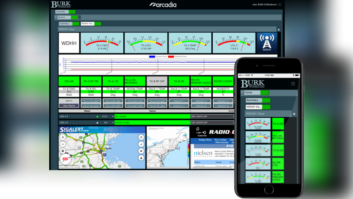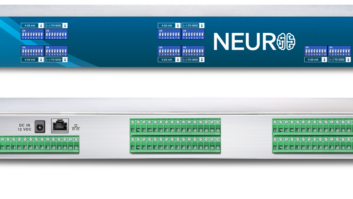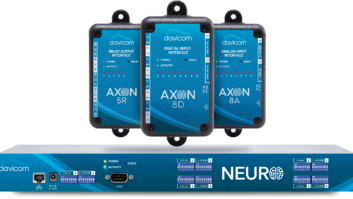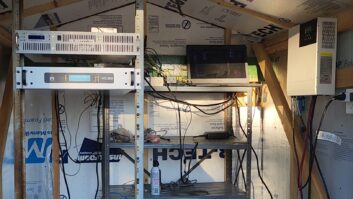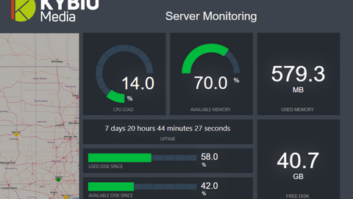Remote Site Control
Aug 1, 2011 1:00 AM, By Doug Irwin, CPBE DRB AMD
Find the fit for the functionality you need with a plethora of choices

The technology behind remote controls has changed dramatically during my time in this business. When I first started I had a remote control that needed dc continuity between the transmitter site and the studio. That was problematic, to say the least. I also had a system that used a super-audible tone going up to the site on the microwave shot, with metering coming back on an SCA. I had another one with metering coming back on a sub-audible tone on an AM station.
Thankfully those are all long gone.
Remote controls that are around today accomplish the same thing that the older units did, but fortunately the communications links between the two ends are different. Adding POTS accessibility in the mid-1980s was great; but, adding IP accessibility (within the last couple of years) was even better. Typical remote controls can now have HTTP, SMTP, SNMP and NTP functionality, making the life of the typical broadcast engineer a little easier.
Because different manufacturers’ products are basically all designed to do the same thing, naturally they have similarities. I’ll point out common features, but I also am going to point out the differences that I think may make or break a purchase decision. Some devices have unique features that deserve attention.

Davicom MAC 216
The first company we’ll talk about is Davicom. A more recent player in the field (having started in 1994), the company has an extensive product line. Specifically, I’ll look at the MAC 216. The stand-alone unit does not require a CPU at the remote site, although one is needed for local control. It features 16 metering inputs, 32 status inputs, 32 relays available on 50-pin Champ connectors. Inputs and outputs are expandable via Modbus. The metering range is �2.5V, �10V, �20V at 12-bit resolution and 100k ohms loading. The status inputs are optically isolated with a 22k ohms loading. It is accessible via HTTP, NTP, SMTP and SNMP. A POTS connection allows it to calls out with voice messages and respond to DTMF commands.
Programmable actions can be taken on conditions or events, and alarm emails can include HTML or XML file attachments. Up to 128 internal timed events can be programmed. There are no internal moving parts (no HDD or fan). It specifies RF immunity in fields up to 10V/m field intensity. The unit occupies 2RU and is 12″ deep.
– continued on page 2
Remote Site Control
Aug 1, 2011 1:00 AM, By Doug Irwin, CPBE DRB AMD
Find the fit for the functionality you need with a plethora of choices
Like all remote control devices in this category, all the inputs, outputs and status connections need to be broken out from their multiple-circuit connectors. The MAC 216 has quite a few unique features. It has a built-in PSTN dial-tone detector. It’s nice to know ahead of time if your phone line to the unit is dead (although you’ll have to be informed via IP in some fashion). It logs caller-ID on incoming calls. (Who was it that just turned the transmitter off?) It has 16 different call-out lists, which is handy because you might want the unit to call a PD directly for a dead-air status alarm. Not everyone on the call-out list has to deal with every type of status alarm then.
MacComm is the software used on the device, and it has four primary features. First, it allows users to configure what Davicom calls workspaces, which allows the user to make up a one-line diagram of the broadcast system being controlled by the unit. It allows for the creation of complex operations by means of virtual logic gates, mathematical functions, qualifiers and inverters. It allows the user to look at telemetry in a graphical form; and finally, it allows the user to see trends in telemetry by means of graphs.

Statmon Axess
Another player in the remote control space is Statmon. While the company offers an extensive product line, the system I’ll focus on is Axess. This system is different than what we’ve typically used over the years because it isn’t a stand-alone box that we think of as a remote control. This is a system that is assembled, and consists of the computer, the Axess software, and the interface known as the GPX-32. A basic remote control system has 32 optically isolated status inputs (either polarity available, 88-264Vac input or 18-60Vdc input), 32 balanced metering inputs (100k ohms, �5Vdc or �15Vdc, 16-bit ADC) and 32 relay outputs. The opto-isolated outputs, relays and metering inputs accessed via a PDP (punch-down panel), which consists of Krone blocks mounted on a 2RU panel. The PDP connects to the GPX-32, which occupies 1RU.
POTS accessibility is via a modem attached to computer running Axess software. Serial ports can be used for communications between Axess and other devices. The CPU and GPX-32 communicate via Ethernet. The unti provides HTTP, SMTP, SNMP and NTP support. Each remote user is assigned level of control based on his password. The current version of Axess will run on Windows 7 Pro, Windows Server 2003 or Windows Server 2008 R2 32/64-bit.
Aside from using a computer to look at all the various pieces of information supplied by the GPX-32, you can use what Statmon calls OVI (Operator Visual Interface) to build a GUI that shows (for example) signal or data flow, equipment layout, or facility parameters such as ac line voltage, room temperature or door alarms. A video camera can also be accessed as an object in OVI. You can build an OVI template, and copy it, then paste it to another site. In addition to OVI, Statmon provides the Statmon Control Language that allows the user to build scripts so that Axess will perform user-defined actions, based upon input status, metering, and control.

Worldcast Systems Audemat Relio
The Worldcast Systems Audemat remote control product is known as Relio. (The particular device I will discuss is actually manufactured by SeaLevel; Audemat makes its own versions known as Relio Silver, along with Relio-mini.) It’s a stand-alone unit that occupie 1RU. All the inputs/outputs are brought to multiple-circuit connectors on the rear panel. There are 64 relay outputs (using two separate relay panels, 2RU each), 64 status inputs (using two separate status panels, 1RU each), and 24 analog inputs (1RU panel) with a 14-bit, �10Vdc input range. Two Ethernet ports, five serial ports (four for RS-232 or RS-485; one for RS-232 only) and four USB ports provide connectivity. A built-in POTS modem with programmable call-out responds to DTMF tones. The unit supports HTTP, SNMP, SMTP and NTP. It uses a Linux-based operating system, Compact Flash storage and a hard drive to store logs.
Like the other units mentioned previously, Relio is a stand-alone unit that lives at the site to be controlled. Even though it supports HTTP, the normal GUI used is called MasterView, and that lives on a computer in the control location. To have access to the Relio at the remote site, you need to place a computer there running MasterView. Configuring of the device is done via software (written by Audemat) known as ScriptEasy. Scripteasy also allows the user to develop scripts, based on objects such as analog inputs, status inputs, relay outputs and other logic operators, so that the device will carry out pre-programmed events. Audemat also has developed two APIs (Advanced Programming Interface) so that Relio can communicate directly (via serial ports) with the Harris Z-series transmitters and the Nautel NV series.
– continued on page 3
Remote Site Control
Aug 1, 2011 1:00 AM, By Doug Irwin, CPBE DRB AMD
Find the fit for the functionality you need with a plethora of choices

Burk ARC Plus
The remote control manufacturer with the most history in our industry has to be Burk. (Moseley and TFT no longer make remote controls, and Gentner’s remote control line was picked up by Burk.) Specifically, let’s take a look at the ARC-16 Plus. A stand-alone, 2RU unit, it connects via Ethernet to a Plus-X Integrated Input Unit for 16 dedicated status inputs and another 16 status/or metering channels (which occupies 1RU). Add a Plus-X Integrated Command Relay unit (also 1RU) for 16 relays. Control access is available via HTTP, while SMTP or SMS can be used for outgoing alarms.
An optional Enhanced Speech Interface is available for remote dial-up control and alarms. The unit has a front-panel vacuum-fluorescent display and jog-wheel and front-panel LCD command buttons with text. The optional PlusConnect directly connects to various transmitters via serial or Ethernet and provides SNMP support.
The ARC Plus is backward compatible with legacy ARC-16 units. Optional AutoPilot 2010 software provides control functionality via PCs running XP, Vista or Windows 7, and allows control of legacy ARC-16 units and the Gentner GSC3000 and VRC2500. Optional Jet-Active flowcharts act as an extension of AutoPilot 2010. They allow user to configure flowcharts that tell the ARC Plus how to respond to different conditions.
Probably the most unique aspect of the ARC Plus (for the purposes of this article) is the fact that it has front-panel controls, which none of the aforementioned remote controls do.
Simpler approach

Broadcast Tools Site Sentinel 16
In some cases, a facility’s remote control application might be fairly simple, and as such any of the four remote controls already discussed would qualify as overkill. Perhaps you just need a more economical alternative; perhaps you need a backup remote control (always nice to have); or perhaps you need remote control for translator or booster site. Fortunately there are many good options available.
As an example, Broadcast Tools offers the Site Sentinel 16. It’s a 1 RU device with 16 channels, each with 12-bit, 0-10Vdc sample, and optically isolated status inputs. There are 33 SPDT relays, programmable as latched or momentary, and a stereo silence sensor. The plug-in Euro-block screw terminals provide access to relays, status inputs and the silence sensor. There are four temperature-probe inputs and a programmable macro sequencer (up to 100 events). HTTP access permits Web browser access, and SMTP support can notify up to eight destinations for email alerts. It also supports SNMP, and keeps time via NTP or a battery-backed clock/calendar. The Site-Sentinel 16 doesn’t have POTS access, only IP access.
– continued on page 4
Remote Site Control
Aug 1, 2011 1:00 AM, By Doug Irwin, CPBE DRB AMD
Find the fit for the functionality you need with a plethora of choices

Sine Systems RFC1/B
Another example of a more economical remote control is the Sine-Systems RFC1/B. This product has been around for a long time and as such probably falls in the classic category for a lot of broadcast engineers. The most basic configuration consists of the control unit (RFC-1/B itself) and at minimum, one interface panel (RP-8) to occupy at least 3RU. It has (at minimum) eight channels of relay control, plus eight metering inputs (per RP-8). Access is via POTS. DTMF is used to program and control the unit. Up to 80 timed events can be configured. The RFC-1/B can be programmed to perform events corresponding to telemetry input. It can call out in the event of alarm conditions.
Accessory options: Additional RP-8s, status input module SIP-8, audio failsafe AFS-3 and temperature sensor module TS-1/ps.
To make programming an RFC 1/B easier, Hydro Hawk has developed the My Sine. This PC application can also store and manage multiple Sine setups for easier retrieval and loading. The Hawk 2B can be used to provide an IP interface to a Sine setup.
Hydro Hawk also manufactures the Air Hawk, which is a stand-alone remote control. It connects via cellular, Wi-fi and Ethernet, and can be accessed with an iPhone/iPad app. Data is logged, stored and displayed on customizable Trend Charts. Eight analog or status input channels can be monitored with the base unit, and the system is expandable to support up to 100 modules. It includes eight opto-isolated outputs. Customized notification sequences are sent via email or text message with multiple contacts defined for each alarm and delays between notifications.

Circuitwerkes TAC-5
Finally, there’s one of the most economical remote control solutions out there, the TAC-5 from CircuitWerkes. If you don’t need telemetry, just actual control functions, then this may be the way to go. Its primary features include:
Five form-A (normally open) relays that can be programmed as latching or momentary. Each relay can be programmed to respond to any of the 16 DTMF tones. One DPDT relay can be used to switch a balanced audio line. All the relays appear on screw terminals. It is POTS accessible, and an up-to-8-digit password can be set for command access, with another password to allow a caller to listen only (no relay command access). It has a built-in audio hybrid with send audio input along with receive audio output. A status input precipitates call-outs by the unit. It is programmed via any DTMF-capable telephone, and it can be mounted on the wall mount or with an optional rack-mount.
It seems pretty clear that the primary design goal of the TAC-5 is to allow a user to remotely control an automation system or other program-source switching. While you are online with the device, the built-in hybrid lets you hear what is going on at the other end. Considering how far-afield some engineers are, this is important because many times you cannot hear the station you are dealing with on the radio. It could simply be too far away.
Remote controls have come a long way from the days when you needed an actual dc continuity circuit from Telco to make it all work. All the telecommunications methods that make our lives easy in other ways have all shown up in these remote control products, thankfully. In this day and age of tight budgets it’s important to let the device you obtain precisely fit the functionality that is needed. With all the devices available out there, that should be pretty easy to do.
Resource Guide
Broadcast Tools
877-250-5575
www.broadcasttools.com
Burk Technology
800-255-8090
www.burk.com
Circuitwerkes
352-335-6555
www.circuitwerkes.com
Davicom
418-682-3380
www.davicom.com
Innovative Broadcast Systems
662-324-2769
www.hawkremote.com
Sine Systems
615-228-3500
www.sinesystems.com
Statmon Technologies
310-440-8053
www.statmon.com
WorldCast Systems
305-249-3110
www.audemat.com
Irwin is transmission systems supervisor for Clear Channel NYC and chief engineer of WKTU, New York. Contact him at [email protected].





